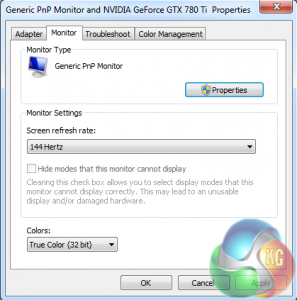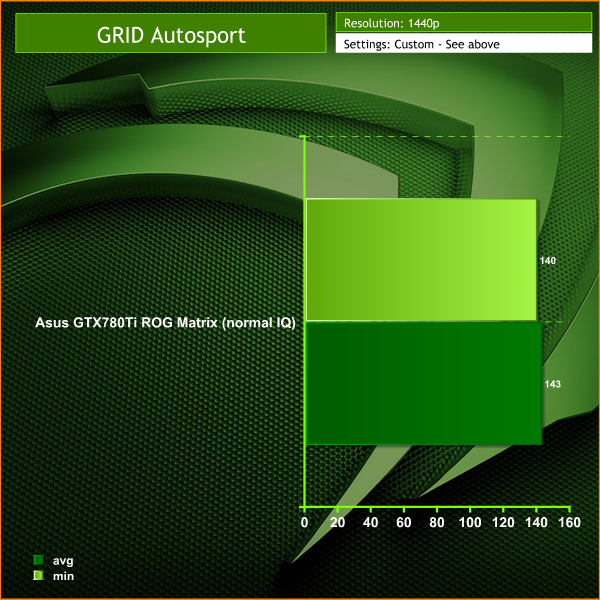We installed the latest Nvidia beta drivers from the official website – version 340.43.  After the initial install, we loaded the driver to check the ‘Set up G-SYNC' panel. It was already enabled. We went into the Manage 3D Settings and checked in the Vertical Sync options that G-SYNC was selected.
After the initial install, we loaded the driver to check the ‘Set up G-SYNC' panel. It was already enabled. We went into the Manage 3D Settings and checked in the Vertical Sync options that G-SYNC was selected.  A double check of the Windows display options, highlighted that 144hertz was enabled by default. We only tested today at the 144hz setting in 2D. Our 3D Vision glasses stopped working just before we started to test the screen and we have been unable to get a replacement pair in time. The first game we decided to test with was the latest version of Tomb Raider – a great game both to play and look at. For the purposes of this specific article we used the built in game benchmark. Remember we want to try and get a constant frame rate of 144 fps to match the maximum 144hz of the screen. This is not going to be easy at 1440p., even with an overclocked GTX780Ti. An advantage to G-Sync is that obviously you still get smooth, tear-free gaming at any frame rate. It is worth pointing out that thanks to Nvidia G-SYNC – there is no stuttering evident when the frame rate drops. We did test with some games that fluctuated between 120 frames per second and 60 frames per second. There was no indication of visible and distracting ‘tearing'. Incidentally you can still use the Asus ROG Swift PG278Q with AMD video cards, but G-SYNC is not supported.
A double check of the Windows display options, highlighted that 144hertz was enabled by default. We only tested today at the 144hz setting in 2D. Our 3D Vision glasses stopped working just before we started to test the screen and we have been unable to get a replacement pair in time. The first game we decided to test with was the latest version of Tomb Raider – a great game both to play and look at. For the purposes of this specific article we used the built in game benchmark. Remember we want to try and get a constant frame rate of 144 fps to match the maximum 144hz of the screen. This is not going to be easy at 1440p., even with an overclocked GTX780Ti. An advantage to G-Sync is that obviously you still get smooth, tear-free gaming at any frame rate. It is worth pointing out that thanks to Nvidia G-SYNC – there is no stuttering evident when the frame rate drops. We did test with some games that fluctuated between 120 frames per second and 60 frames per second. There was no indication of visible and distracting ‘tearing'. Incidentally you can still use the Asus ROG Swift PG278Q with AMD video cards, but G-SYNC is not supported. 
 We first tested with the ‘HIGH' quality preset, and then the ‘NORMAL' quality preset.
We first tested with the ‘HIGH' quality preset, and then the ‘NORMAL' quality preset. 

 At the High image quality preset, the frame rate dropped in the more intensive sections of the benchmark to around 110 frames per second, with an average of 133 frames per second. Reducing the image quality to the Normal quality preset helped to hold the frame rate very close to a constant 144 frames per second. Next game to test was the latest version of GRID – entitled GRID Autosport. This was released a couple of weeks ago.
At the High image quality preset, the frame rate dropped in the more intensive sections of the benchmark to around 110 frames per second, with an average of 133 frames per second. Reducing the image quality to the Normal quality preset helped to hold the frame rate very close to a constant 144 frames per second. Next game to test was the latest version of GRID – entitled GRID Autosport. This was released a couple of weeks ago. 

 The ULTRA and HIGH settings were certainly usable, but frame rates dropped well below 110 fps. It didn't effect the perceived smoothness of the game, but we wanted to ascertain the settings we need to use to get an almost constant 144fps – matching the maximum hz of the Asus ROG Swift PG278Q.
The ULTRA and HIGH settings were certainly usable, but frame rates dropped well below 110 fps. It didn't effect the perceived smoothness of the game, but we wanted to ascertain the settings we need to use to get an almost constant 144fps – matching the maximum hz of the Asus ROG Swift PG278Q. 
 The normal image quality setting worked best if we wanted to hold the frame rate at the maximum of the panel. At these settings, the engine was running at almost a constant 144 frames per second. The game experience was fantastic. When we cranked the Anti Aliasing to 8 times and the image quality to maximum, the frame rate dropped to between 60-100 frames per second. Motion was still smooth and we saw no signs of artifacting or stuttering.
The normal image quality setting worked best if we wanted to hold the frame rate at the maximum of the panel. At these settings, the engine was running at almost a constant 144 frames per second. The game experience was fantastic. When we cranked the Anti Aliasing to 8 times and the image quality to maximum, the frame rate dropped to between 60-100 frames per second. Motion was still smooth and we saw no signs of artifacting or stuttering.
Home / Tech News / Featured Tech Reviews / Asus ROG Swift PG278Q 144hz G-Sync Monitor (w/ GTX 780Ti ROG Matrix)
Tags Review
Check Also
Ducky One 3 Pro Nazca Line Keyboard Review
The One 3 Pro Nazca Line keyboard from Ducky feature the revamped Cherry MX2A switches
 KitGuru KitGuru.net – Tech News | Hardware News | Hardware Reviews | IOS | Mobile | Gaming | Graphics Cards
KitGuru KitGuru.net – Tech News | Hardware News | Hardware Reviews | IOS | Mobile | Gaming | Graphics Cards



And what about the 3D ???
This is the worlds 1st 1440p 3D moniter you know !
This one will be not 500 euros … its will cost in europe 1100 euros For Tn …
ok i will be willing spent 600-800 euros but over grand go fish..
already explained that in the review Chris.
Great review! I’ve been waiting on a review for one of these for quite some time now. Now that I know the quality of the display is about as high as you can expect from a TN panel, I feel more comfortable with dropping $800 on one.
Is this 3D? With NVIDIA 3D Vision and Lightboost?
In the pictures I can’t see the sensor that activates 3D when I put the glasses on. Just like on VG278HR
Too late, Delayed too long with this so I got the 4k instead and there is no going back to lower resolution gaming for me. 😉
This monitor will be support FreeSync and AMD HD3D technology ?
I was going to buy R295x2, but after this news, I must get full asus rog equipment with this screen and g-sync, cant wait!
When can I buy it?!?!
FFS. When can I get this in the US?
I’m sorry but have the reviewers missed the point in g-sync?
You don’t have to get 144+ FPS anymore to avoid screen tearing, and that’s the hole point in g-sync.
if you have the hardware that can pull 144 fps in every game g-sync doesn’t bring anything to the table only additional cost.
the smart thing about g-sync is that it syncs the refresh rate on the screen with your current frame rate, by doing this, you avoid seeing any tearing, it also means that you can keep v-sync enabled in most games, as the graphics card and the screen will deal with the synchronization.
G-Sync solves the issue where the refresh rate would drop to 30hz of you are getting lower than 60 fps, on 60hz monitors.
Only $799 in America but £720 in UK ($1235).
LOL!
This is 6990,- in Norway (£660 or $1114)